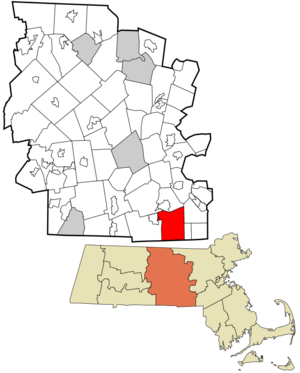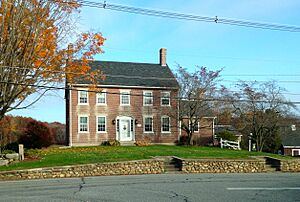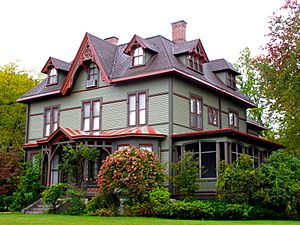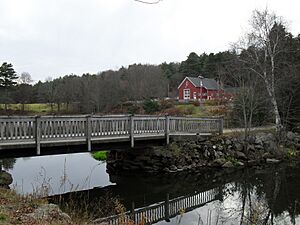Uxbridge, Massachusetts facts for kids
Quick facts for kids
Uxbridge
|
|||
|---|---|---|---|

Congregational Church and Civil War Memorial
|
|||
|
|||
| Nickname(s):
"Cradle of the Industrial Revolution" "Heart of The Blackstone Valley" "A Crossroads Village"
|
|||
| Motto(s):
"Weaving a Tapestry of Early America" “President George Washington really did sleep here”
|
|||

Location in Worcester County and the state of Massachusetts.
|
|||
| Country | United States | ||
| State | Massachusetts | ||
| County | Worcester | ||
| Colonized | 1662 | ||
| Incorporated | 1727 | ||
| Government | |||
| • Type | Open town meeting | ||
| Area | |||
| • Total | 30.4 sq mi (78.7 km2) | ||
| • Land | 29.5 sq mi (76.5 km2) | ||
| • Water | 0.8 sq mi (2.1 km2) | ||
| Elevation | 270 ft (82 m) | ||
| Population
(2020)
|
|||
| • Total | 14,162 | ||
| • Density | 480.1/sq mi (185.1/km2) | ||
| Time zone | UTC-5 (Eastern) | ||
| • Summer (DST) | UTC-4 (Eastern) | ||
| ZIP code |
01569
|
||
| Area code(s) | 508 / 774 | ||
| FIPS code | 25-71620 | ||
| GNIS feature ID | 0618387 | ||
| Website | http://www.uxbridge-ma.gov/ | ||
Uxbridge is a town in Worcester County, Massachusetts, United States. It was first settled in 1662 and became an official town in 1727. Uxbridge was originally part of the town of Mendon. It was named after the Earl of Uxbridge.
The town is about 36 miles southwest of Boston and 15 miles south-southeast of Worcester. It sits in the middle of the Blackstone Valley National Historic Park. Uxbridge is known as the "Heart of The Blackstone Valley" and "the Cradle of the Industrial Revolution." It was a very important center for making textiles during the American Industrial Revolution.
Two members of the Quaker community from Uxbridge were important leaders in the movement to end slavery in America. The town is said to have given voting rights to America's first colonial woman voter, Lydia Taft. It also approved Massachusetts's first women jurors. The first hospital for mental illness in America was reportedly started here. Deborah Sampson pretended to be a male soldier from Uxbridge and fought in the American Revolution.
Uxbridge has a long history of making military uniforms and clothing. This started in 1820 with new power looms. The town became famous for its soft woolen fabrics, especially cashmeres. The first U.S. Air Force dress uniform, called "Uxbridge Blue," was made here. Today, the BJ's Wholesale Club distribution warehouse is a major employer in the town. In 2020, Uxbridge had a population of 14,162 people.
Contents
History of Uxbridge
Early Days and the Revolution
Long ago, Nipmuc people lived near a river bend they called "Wacentug" or "Waentug." In the 1600s, they sold land to settlers. The town of Mendon began in 1667 but was later burned during King Phillips War. Many Nipmuck people joined the native uprising and sadly died.
Western Mendon became Uxbridge in 1727. The first town meeting was held at the Farnum House. John Adams' uncle, Nathan Webb, was the first minister of the town's new church. The famous American Taft family has strong roots in Uxbridge and Mendon. Lydia Taft is believed to have voted in a town meeting in 1756. This is thought to be the first time a colonial woman voted.
During the time of the American Revolution, people like Seth Read, Joseph Read, and Simeon Wheelock were part of groups that helped spread news and organize protests. Baxter Hall was a drummer for the Minutemen. Seth Read fought in the Battle of Bunker Hill. George Washington even stopped at Reed's tavern on his way to lead the Continental Army. Samuel Spring was one of the first chaplains (religious leaders) for the American Revolution.
A woman named Deborah Sampson famously joined the army by pretending to be a man named "Robert Shurtlieff of Uxbridge." Later, a protest known as Shays' Rebellion also started here. Governor John Hancock helped calm the protests in Uxbridge. Simeon Wheelock died while protecting the Springfield Armory. Seth Reed helped add the phrase "E pluribus unum" (meaning "out of many, one") to U.S. coins. President Washington also slept in Uxbridge during his first tour of the country.
Quakers and the Fight Against Slavery
Many Quakers, including Richard Mowry, moved to Uxbridge from Rhode Island. They built mills, railroads, houses, tools, and even Conestoga wagon wheels. The Friends Meetinghouse was a place where important abolitionists like Abby Kelley Foster and Effingham Capron met.
Capron led a local anti-slavery group with 450 members. Brister Pierce, who was once enslaved in Uxbridge, signed a petition in 1835 asking Congress to end slavery and the slave trade in Washington D.C. The strong religious beliefs of the early Congregational and Quaker communities in Uxbridge helped shape the town's history.
Industrial Growth and Mills
Uxbridge started with small iron forges in colonial times. But big industries began around 1775. Richard Mowry built machines to make woolen, linen, or cotton cloth. He also built gristmills (for grinding grain) and sawmills. In 1809, Daniel Day built the first woolen mill. By 1855, workers in Uxbridge were making 2.5 million yards of cloth each year!
Uxbridge became home to over twenty different industrial mills. A small silver vein was found in the 1830s, but mining for it was not successful.
New ideas and inventions came from Uxbridge. These included power looms (machines that made weaving faster) and ways to make wool into clothing all in one place. They also created new fabric blends and yarn spinning methods. Different villages in Uxbridge grew around these mills, with shops, worker housing, and farms.
The American Woolen Company, Waucantuck Mill, and a shoe factory were located in areas like Hecla and Wheelockville. Daniel Day, Jerry Wheelock, and Luke Taft all used water power for their mills. Moses Taft's mill, the Central Woolen, made cloth continuously, even for the Civil War.
North Uxbridge had Clapp's cotton mill from 1810, and the Rivulet Mill owned by Chandler Taft and Richard Sayles. There was also a granite quarry (a place where stone is dug). This quarry provided stones for New York City, the Statue of Liberty, and other big projects. Peter Rawson Taft's grandson, William Howard Taft, who later became president, visited the Samuel Taft House in Uxbridge.
The mills of John Sr., Effingham, and John W. Capron were pioneers in making satinets (a type of fabric) and using woolen power looms in the U.S. The Bachman-Uxbridge company became very successful. They made uniforms for the U.S. Army during the Civil War, World War I, and World War II. They also made uniforms for nurses and the very first Air Force dress uniforms, known as "Uxbridge Blue."
Recent History
In recent times, state and national parks have been created around the old mills and rivers, and the rivers have been cleaned up. Some movies, like The Great Gatsby (1974) and Oliver's Story (1978), were filmed in Uxbridge, including at the Stanley Woolen Mill.
The Blackstone Valley National Historic Park includes the 1,000-acre Blackstone Canal Heritage State Park. It also has 9 miles of the Blackstone River Greenway and the West Hill Dam. Many historic homes, including 60 Federalist-style homes, have been added to lists of important historical sites.
The Capron wooden mill survived a fire in 2007. The Stanley mill is being restored, but most of the Waucantuck Mill was taken down. In 2013, more fires affected the town, including a historic bank and an old Quaker home.
Today, five groups of the original Nipmuck people live in the Worcester County area. In 2017, a new fire station was built on Main Street. It has five bays for fire trucks and rooms for staff.
Uxbridge has also seen recent sports success! The Uxbridge High Spartans football team won the 2023 and 2024 Division 7 Super Bowls with undefeated records. The Uxbridge High Spartans Field Hockey Team won its third state championship in a row in 2023.
Geography and Climate
Uxbridge covers about 30.4 square miles. About 0.8 square miles of this is water. The town is located 39.77 miles southwest of Boston, 16 miles southeast of Worcester, and 20 miles northwest of Providence. The land in Uxbridge ranges from 200 feet to 577 feet above sea level.
Uxbridge shares borders with several other towns: Douglas, Mendon, Millville, Northbridge, and Sutton, Massachusetts. It also borders two towns in Rhode Island: Burrillville and North Smithfield.
 |
Sutton | Northbridge | Mendon |  |
| Douglas | Millville | |||
| Burrillville, Rhode Island | North Smithfield, Rhode Island |
Weather in Uxbridge
Uxbridge has a continental climate with cold winters and warm summers. Snowfall can happen from November to April. The highest temperature ever recorded was 104 degrees Fahrenheit in July 1975. The lowest was -25 degrees Fahrenheit in January 1957.
| Climate data for Uxbridge, Massachusetts | |||||||||||||
|---|---|---|---|---|---|---|---|---|---|---|---|---|---|
| Month | Jan | Feb | Mar | Apr | May | Jun | Jul | Aug | Sep | Oct | Nov | Dec | Year |
| Mean daily maximum °F (°C) | 37 (3) |
40 (4) |
49 (9) |
59 (15) |
70 (21) |
79 (26) |
84 (29) |
82 (28) |
75 (24) |
64 (18) |
53 (12) |
42 (6) |
61 (16) |
| Mean daily minimum °F (°C) | 13 (−11) |
16 (−9) |
27 (−3) |
37 (3) |
47 (8) |
55 (13) |
60 (16) |
59 (15) |
49 (9) |
37 (3) |
30 (−1) |
20 (−7) |
38 (3) |
| Average precipitation inches (mm) | 3.6 (91) |
3.3 (84) |
4.1 (100) |
3.9 (99) |
4.3 (110) |
3.6 (91) |
3.7 (94) |
4.1 (100) |
4.1 (100) |
4.1 (100) |
4.5 (110) |
4.0 (100) |
47.3 (1,200) |
| Source: Weather.com | |||||||||||||
People and Economy
| Historical population | ||
|---|---|---|
| Year | Pop. | ±% |
| 1790 | 1,308 | — |
| 1800 | 1,404 | +7.3% |
| 1810 | 1,404 | +0.0% |
| 1820 | 1,551 | +10.5% |
| 1830 | 2,086 | +34.5% |
| 1840 | 2,004 | −3.9% |
| 1850 | 2,457 | +22.6% |
| 1860 | 3,133 | +27.5% |
| 1870 | 3,058 | −2.4% |
| 1880 | 3,111 | +1.7% |
| 1890 | 3,408 | +9.5% |
| 1900 | 3,599 | +5.6% |
| 1910 | 4,671 | +29.8% |
| 1920 | 5,384 | +15.3% |
| 1930 | 6,285 | +16.7% |
| 1940 | 6,417 | +2.1% |
| 1950 | 7,007 | +9.2% |
| 1960 | 7,789 | +11.2% |
| 1970 | 8,253 | +6.0% |
| 1980 | 8,374 | +1.5% |
| 1990 | 10,415 | +24.4% |
| 2000 | 11,156 | +7.1% |
| 2010 | 13,457 | +20.6% |
| 2020 | 14,162 | +5.2% |
| 2023* | 14,526 | +2.6% |
| * = population estimate. Source: United States Census records and Population Estimates Program data. |
||
In 2010, Uxbridge had 13,457 people living in 5,056 homes. Most residents (95.7%) were White. The average income per person was $24,540. Only a small number of people (4.7%) lived below the poverty line.
Jobs in Uxbridge
Uxbridge offers jobs in many areas, including technology, services, distribution, healthcare, local government, education, and tourism. A large distribution center for BJ's Wholesale Club is a major employer. The unemployment rate in Uxbridge is often lower than the state average.
Fun Things to See and Do
Places to Visit
- "Uxbridge," a film by Chris Bilodeau Photography (2017)
- National historic sites
- Lt. Simeon Wheelock House, built in 1768
- Friends Meetinghouse, built around 1770
- Taft House, visited by George Washington in 1789 and by his grandson, William Howard Taft, in 1910
- Crown and Eagle Cotton Mill, built around 1826
- Elmshade, where a famous Taft family reunion happened in 1874
- Bernat Mill, also known as Capron Mill (around 1820) and Uxbridge Worsted Company
- Stanley Woolen Mill, also called Central Woolen, Calumet, and Moses Taft Mill
- Blackstone River Valley National Heritage Corridor
- National Park Service sites in Millville and Uxbridge
- Blackstone Canal at River Bend Farm
- Blackstone River and Canal Heritage State Park
- River Bend Farm and Canal
- West Hill Dam and its recreation area
- Blissful Meadows Golf Club
Education in Uxbridge
Uxbridge has several schools for different age groups. These include the Earl D. Taft Early Learning Center (Pre-K to 3rd grade), Whitin Intermediate School (4th to 7th grade), and Uxbridge High School (8th to 12th grade). There is also a private school called Our Lady of the Valley Regional.
Uxbridge is part of the Blackstone Valley Regional Vocational School District. This means that students in eighth grade can apply to attend Blackstone Valley Regional Vocational Technical High School, which serves grades 9-12. The New York Times once called Uxbridge's education changes a "little revolution" because they focused on meeting the needs of families.
Getting Around Uxbridge
Transportation Options
Trains
The closest train stops for commuters are Forge Park/495, Grafton, and Worcester. These are about 15 miles away. A freight train line, the Providence and Worcester Railroad, also goes through Uxbridge.
Roads
Major roads in Uxbridge include Route 146, Route 16, Route 122, Route 98, and Route 146A.
Airports
For commercial flights, people can use TF Green State Airport in Warwick-Providence, Worcester Regional Airport, or Boston Logan International Airport. Smaller planes can use Hopedale Airport, which is about 7.2 miles away, or Worcester Regional Airport.
Healthcare
The Tri-River Family Health Center offers basic medical care. Larger hospitals like Milford Regional and Landmark Medical Center are also nearby.
Famous People from Uxbridge
- Benjamin Adams, a Congressman
- Willard Bartlett, a Chief Justice in New York
- Franklin Bartlett, a Congressman
- Nicholas Baylies, a Justice of the Vermont Supreme Court
- Ezra ("T".) Taft Benson, a religious leader and politician
- Alice Bridges, an Olympic bronze medalist in swimming
- Phineas Bruce, a Congressman
- Edward P. Bullard, who started Bullard Machine tools, which helped make cars
- Tyler Burton, a basketball player
- Effingham Capron, a leader in the anti-slavery movement and an industrialist
- Julius Angelo Carpenter, who founded Carpentersville, Illinois
- Daniel Day, who started one of the first woolen mills in the U.S.
- Tim Fortugno, a baseball player for the California Angels and Chicago White Sox
- Albert Harkness, a famous Latin scholar
- Kevin Kuros, a former state politician
- Jacqueline Liebergott, a former president of Emerson College
- Arthur MacArthur Sr., a Lieutenant Governor and Chief Justice, and grandfather of Douglas MacArthur
- Mike Mahoney (American football), a former football coach
- Joshua Macomber, an educator
- Richard Moore, a former state senator and FEMA executive
- William Augustus Mowry, an educator
- Jeannine Oppewall, nominated for four Academy Awards for art direction
- Willard Preston, a former president of the University of Vermont
- Seth Reed, a Revolutionary War fighter who helped add "E pluribus unum" to U.S. coins
- Joseph Read, a Colonel in the American Revolutionary War
- Brian Skerry, a National Geographic photographer
- Edward Sullivan, who won a Congressional Medal of Honor
- Robert Taft I, the founder of the Taft family political dynasty
- Robert Taft, 2nd, a town leader
- Josiah Taft, a wealthy landowner and husband of Lydia Taft
- Lydia (Chapin) Taft, the first woman to vote in America
- Bezaleel Taft Sr., a captain in the American Revolution and state politician
- Bezaleel Taft Jr., a state politician who owned the historic Elmshade home
- Samuel Taft, who hosted George Washington
- Luke Taft, who built two water-powered textile mills
- Moses Taft, who built the Stanley Woolen Mill
- Peter Rawson Taft I, the grandfather of William Howard Taft
- Nathan Webb, the first minister of the new Congregational Church and uncle of John Adams
- Arthur K. Wheelock Jr., a curator at the National Gallery of Art
- Leonard White (physician), an early Uxbridge doctor who studied mosquitoes
- Samuel Willard (physician), an early Uxbridge doctor who helped treat mental health issues
- Paul C. Whitin, who founded Whitin Machine Works
- Charles Vacanti, a doctor known for tissue engineering and stem cells
See also
 In Spanish: Uxbridge (Massachusetts) para niños
In Spanish: Uxbridge (Massachusetts) para niños







